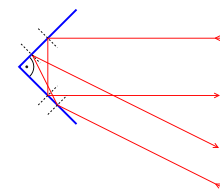Bicycle Reflectors
Description of a bicycle reflector
Bicycle reflectors comprise hundreds of cube corner reflectors that look like a honeycomb of hexagonal cells. These cells reflect light that shines on them back to its source, using the principle of total internal reflection.
The walls of the hexagonal cells are angled precisely right to allow TIR to occur. Light travels in a straight line, but the angles in a cube-corner cell are such that a beam of light bounces off one wall, then against another wall, and so on, continually retracing its path. The light exits from the bicycle reflector and refracts as the car's headlights begin to pass beyond the cyclist.
Advantages
-There is no need for the use of energy or electricity to power bicycle reflectors
-The reflector is convenient and user friendly: It is located at the spokes of the wheels, under the seat of a bicycle, or in front. It does not need to be switched on before using.
Disadvantages
-In order for bike reflectors to work effectively, the angle of the light source (car headlights) must shine directly at them. If the headlights are not at a desirable angle, the light rays are refracted outside of the plastic cube-corner cells rather than being reflected inside them.
-In bad weather, (fog or rain) light rays are spread and dispersed, causing the reflectors to become less effective.
-Dirty car headlights and dirty bike reflectors also can impair the function of bike reflectors by blocking the light rays from entering and refracting form the bicycle reflector. (or blocking light rays leaving car headlights).
Photos taken from: http://en.wikipedia.org/wiki/Bicycle_reflector
Information taken from: http://www.ehow.com/how-does_5208844_do-bicycle-reflectors-work_.html
Done by: Ethan Soh, Aaron Sng, Wee Ren Chang


No comments:
Post a Comment